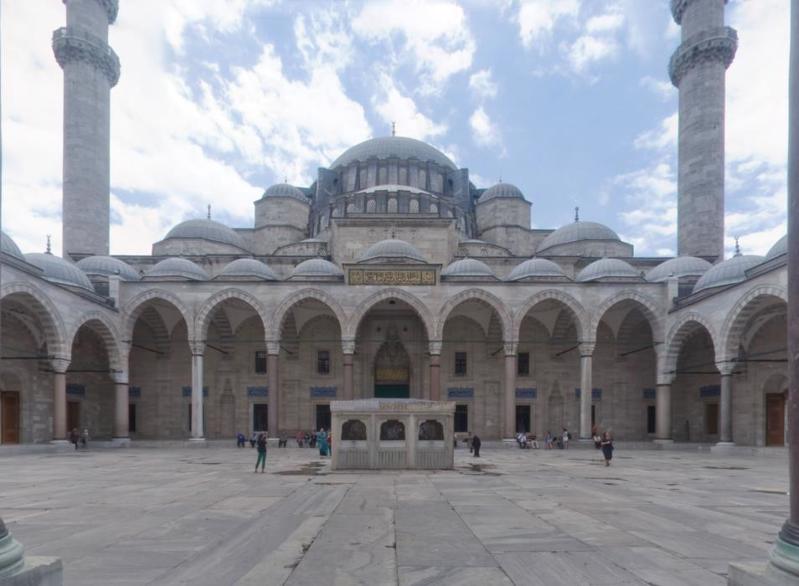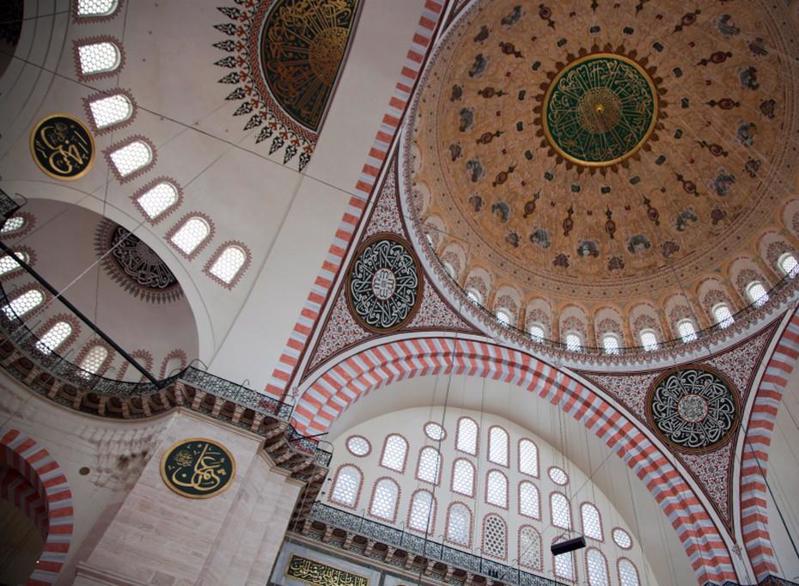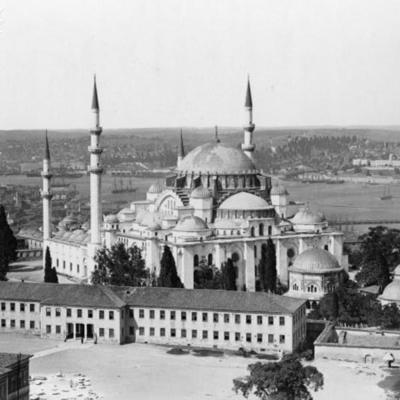A ticket to Ottomans Era
Suleymaniye Mosque is one of the fascinating buildings from Ottomans. The architecture of the Suleymaniye Mosque was Ottoman architect Sinan. He had worked on more than 400 buildings.1 "Among the most famous buildings credited to his authorship are three mosques; the Shehzade Mosque in Istanbul from his 'apprenticeship' period, the Süleymaniye Mosque in Istanbul from his 'qualification' period, and the Selimiye Mosque in Edirne from his 'master' period." 2 Sai Mustafa Celebi wrote Sinan’s memories about his constructions, collected in Tezkirat' ul Bunyan.
In the construction of the Suleymaniye Mosque, there were four single marble columns. These columns were gathered from different countries. The transportation process was strenuous as described in Tezkirat' ul Bunyan, "And we collected massive lighter cables in one place and bound them with hawsers thick a.s a man's body to iron pulley blocks. And. in the place where it stood, we firmly bound the entire shaft of the abovementioned column with galley masts and attached those ships" cables thick as a man's body to the steel
nbo12345nbo
5 chapters
16 Oct 2020
Suleymaniye Mosque
April 19, 1578
|
Istanbul
Suleymaniye Mosque is one of the fascinating buildings from Ottomans. The architecture of the Suleymaniye Mosque was Ottoman architect Sinan. He had worked on more than 400 buildings.1 "Among the most famous buildings credited to his authorship are three mosques; the Shehzade Mosque in Istanbul from his 'apprenticeship' period, the Süleymaniye Mosque in Istanbul from his 'qualification' period, and the Selimiye Mosque in Edirne from his 'master' period." 2 Sai Mustafa Celebi wrote Sinan’s memories about his constructions, collected in Tezkirat' ul Bunyan.
In the construction of the Suleymaniye Mosque, there were four single marble columns. These columns were gathered from different countries. The transportation process was strenuous as described in Tezkirat' ul Bunyan, "And we collected massive lighter cables in one place and bound them with hawsers thick a.s a man's body to iron pulley blocks. And. in the place where it stood, we firmly bound the entire shaft of the abovementioned column with galley masts and attached those ships" cables thick as a man's body to the steel

blocks in two places. And in many places, we set up powerful capstans and treadmills like the wheel of heaven. Many thousand novices {acemioglan) entered the treadmill, and thousands of the demons of Solomon from among the Frankish prisoners shouted. "Heave ho!" for good luck and attached a strong reserve |cable to the above-mentioned cables. And. when with [shouts of] "God! God!" they uprooted the abovementioned column that was like the axis of the celestial sphere, sparks were scattered from the blocks like lightning."3 Those columns were brought from Kiztasi (Istanbul), Alexandria (Egypt), Baalbek (Lebanon), Topkapi Palace (Istanbul).4
The mosque is the part of the Süleymaniye Külliyesi (Islam -Ottoman social complex).
Külliye contains four medrese (educational institution), medical school, hospital, dârulhadis medresesi (school of teaching hadith), sibyan mektebi (elementary school), dârulkurrâ (school of teaching Qur'an),tabhane (lodging section, free charge for three days), dârûzziyâfe (dining hall), kervansaray (roadside inn), stores, hamam (bathroom) and tombs.5 Kulliye was a multifunctional unit in Ottomans. It has a religious, economic, educational, medical, and social significance, and Suleymaniye Mosque was the heart of this unit.
The architectural structures in the mosque have meaning. For

example, the dome represents Islam; four columns represent four caliphs, four minarets represent the 4th Ottoman Sultan after Istanbul's conquest (Suleyman the Magnificent), and ten minaret balconies represent 10th Ottoman Sultan Suleyman the Magnificient.6 Because of the hard work and sensitive calculations, it took seven years to complete the outstanding mosque Suleymaniye.
Notes
1. Özgür Ediz and Michael J. Ostwald, "The Süleymaniye Mosque: A Computational Fractal Analysis of Visual Complexity and Layering in Sinan's Masterwork," Arq : Architectural Research Quarterly 16, no. 2 (06, 2012): 171-182, p.171, doi:http://dx.doi.org.eznvcc.vccs.edu:2048/10.1017/S1359135512000474.
2. Ibid
3. Howard Crane and Esra Akin, Sinan's Autobiographies: Five Sixteenth-Century Texts, (Leiden: Brill, 2006), 123.
4. Ibid
5. Ferhat Aslan, "Süleymaniye Camii Efsaneleri," Journal of Academic Studies 12, no. 47/48 (November 2010): 333–52, p.336, https://search-ebscohost-com.eznvcc.vccs.edu:2443/login.aspx?direct=true&db=a9h&AN=56647213&site=ehost-live&scope=site.

6. Ferhat Aslan,"Süleymaniye Camii Efsaneleri," Journal of Academic Studies 12, no. 47/48 (November 2010): 333–52, p. 347, https://search-ebscohost-com.eznvcc.vccs.edu:2443/login.aspx?direct=true&db=a9h&AN=56647213&site=ehost-live&scope=site.
Bibliography
1. Aslan Ferhat. "Süleymaniye Camii Efsaneleri." Journal of Academic Studies 12, no. 47/48 (November 2010): 333–52. https://search-ebscohost-com.eznvcc.vccs.edu:2443/login.aspx?direct=true&db=a9h&AN=56647213&site=ehost-live&scope=site.
2. Built by Sultan Suleyman the Magnificent; designed by royal architect Mimar Sinan; restored by Sultan Mehmed IV after a fire damage. Built circa 1550-1558; damaged by fire circa 1660; restored circa 1660-1687; part of the dome collapsed during an earthquake in 1766; repaired again soon after; circa 1914?1918 the structure suffered another fire; fully restored in 1956, Image: April, 2010. Suleymaniye Mosque Complex, Interior. https://library-artstor-org.eznvcc.vccs.edu:2443/asset/ASITESPHOTOIG_10313843248.
3. Crane, Howard, and Esra Akin. Sinan's Autobiographies: Five Sixteenth-Century Texts. Leiden: Brill, 2006.
4. Ediz, Özgür and Michael J. Ostwald. "The Süleymaniye Mosque: A Computational Fractal Analysis of Visual Complexity and Layering in Sinan's Masterwork." Arq : Architectural Research Quarterly 16, no. 2 (06, 2012): 171-182. doi:http://dx.doi.org.eznvcc.vccs.edu:2048/10.1017/S1359135512000474.
5. Istanbul, Süleymaniye Mosque, Photo, 18. Photo. Encyclopædia Britannica ImageQuest. Accessed Oct 17, 2020.
https://quest.eb.com/search/109_225847/1/109_225847/cite.
6. Sinan (Mimar Sinan) (Ottoman architect, ca 1500-1588); Sultan Süleyman (Ottoman sultan, 1494 - 1566). 1548-1559 (1557, inaguration of mosque), July 2013. Süleymaniye Camii (Suleymaniye Mosque), Exterior: Courtyard arcade. architecture, ceramics. https://library-artstor-org.eznvcc.vccs.edu:2443/asset/AWSS35953_35953_25702051.
Share your travel adventures like this!
Create your own travel blog in one step
Share with friends and family to follow your journey
Easy set up, no technical knowledge needed and unlimited storage!